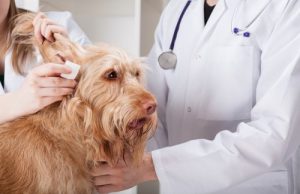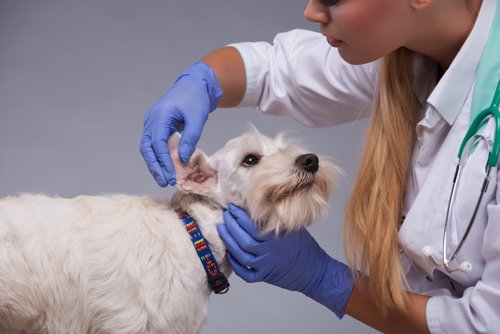Dog Breeds Prone to Having Otitis


Written and verified by the lawyer Francisco María García
Otitis is a very common disease in dogs. However, some breeds are more prone to having this disease than others. This is due to multiple factor that have to do with their hygiene, physiognomy and behavior.
Otitis is inflammation in the ear. It can be external, when it occurs from the eardrum and outward, or internal, which is when it affects the ear’s membrane and nerve endings. External otitis is the most common, in both people and animals. However, malpractice can cause a more severe infection that can cause loss of hearing.
Causes of otitis in dogs
There are many reasons why otitis might develop. Specialists usually classify them as primary or secondary causes.

The primary causes of ear pain have to do with the environment and your dog’s habits. For example, your dog might live in a very humid environment and may be accustomed to bathing constantly. Also, this medical condition can result from allergies, infections, or foreign objects inside the ear. The most common ones are thorns or twigs that the animal can’t remove on his own.
Secondary causes come from other pathologies or conditions. For example, the presence of bacteria, fungi, or yeast don’t cause the disease but do lead to infections. Otitis itself can also cause further infection. An external infection can spread and affect the interior, or fibrosis or calcifications can cause it.
Breeds prone to otitis
A dog’s breed can also be one of the primary causes of otitis. Dogs with droopy ears or small ear canals are more prone to this disease. For example, the anatomy of a Cocker Spaniel’s ear doesn’t allow proper ventilation, which keeps the ear moist with low oxygen levels. This condition occurs in Beagles and Basset Hounds as well.

Dogs with a lot of hair inside their ears are also prone to contracting this disease, because they can accumulate a lot of secretions. This situation can result to allergies or infection. Breeds like Yorkshire Terriers, Collies, and German and Belgian Shepherds contract disease. It’s very common in very hairy or long-haired dogs.
Caring for dogs prone to otitis
Hygiene is essential for dogs who are prone to this ailment. Talk to a specialist before you starting trying out any cleaning techniques. Although all pets need to keep their ears clean, the way to do it isn’t the same for every dog breed.
The first thing to do is to keep the ear free of secretions, especially in dogs with lots of hair in their ears. Don’t use cotton swabs, because they can cause internal injuries. Only clean externally, as far as your fingers can reach.

Dogs that are prone to contracting otitis shouldn’t be bathed often— a good bath once a month is enough. The rest of the time, you can just wash his body without wetting his head. It’s important to clean away excess moisture on the animal: for example, when you take him to the beach, or when the weather is very humid, may cause ear infections.
How to identify this disease
Below are easily identifiable symptoms of external otitis:
- When a dogs scratches his ears often. They might also rub them against the ground.
- Frequent shaking of the head.
- They get aggressive when you try to touch their ears.
- There’s a higher frequency of ear secretions.
- In chronic cases, there is loss of balance or disorientation. There’s also more accumulation of blood in the pinna.
When you see any of these symptoms, you should have the dog get checked by a specialist. They can check the ear with an otoscopy, and analyze secretions using a cytology. In more complex cases, scraping, cropping, a biopsy, or an X-ray may be performed.
Treatment lasts between 21 and 30 days, and usually involves topical and oral medications. No matter what, a health professional should determine steps to take.
Otitis is a very common disease in dogs. However, some breeds are more prone to having this disease than others. This is due to multiple factor that have to do with their hygiene, physiognomy and behavior.
Otitis is inflammation in the ear. It can be external, when it occurs from the eardrum and outward, or internal, which is when it affects the ear’s membrane and nerve endings. External otitis is the most common, in both people and animals. However, malpractice can cause a more severe infection that can cause loss of hearing.
Causes of otitis in dogs
There are many reasons why otitis might develop. Specialists usually classify them as primary or secondary causes.

The primary causes of ear pain have to do with the environment and your dog’s habits. For example, your dog might live in a very humid environment and may be accustomed to bathing constantly. Also, this medical condition can result from allergies, infections, or foreign objects inside the ear. The most common ones are thorns or twigs that the animal can’t remove on his own.
Secondary causes come from other pathologies or conditions. For example, the presence of bacteria, fungi, or yeast don’t cause the disease but do lead to infections. Otitis itself can also cause further infection. An external infection can spread and affect the interior, or fibrosis or calcifications can cause it.
Breeds prone to otitis
A dog’s breed can also be one of the primary causes of otitis. Dogs with droopy ears or small ear canals are more prone to this disease. For example, the anatomy of a Cocker Spaniel’s ear doesn’t allow proper ventilation, which keeps the ear moist with low oxygen levels. This condition occurs in Beagles and Basset Hounds as well.

Dogs with a lot of hair inside their ears are also prone to contracting this disease, because they can accumulate a lot of secretions. This situation can result to allergies or infection. Breeds like Yorkshire Terriers, Collies, and German and Belgian Shepherds contract disease. It’s very common in very hairy or long-haired dogs.
Caring for dogs prone to otitis
Hygiene is essential for dogs who are prone to this ailment. Talk to a specialist before you starting trying out any cleaning techniques. Although all pets need to keep their ears clean, the way to do it isn’t the same for every dog breed.
The first thing to do is to keep the ear free of secretions, especially in dogs with lots of hair in their ears. Don’t use cotton swabs, because they can cause internal injuries. Only clean externally, as far as your fingers can reach.

Dogs that are prone to contracting otitis shouldn’t be bathed often— a good bath once a month is enough. The rest of the time, you can just wash his body without wetting his head. It’s important to clean away excess moisture on the animal: for example, when you take him to the beach, or when the weather is very humid, may cause ear infections.
How to identify this disease
Below are easily identifiable symptoms of external otitis:
- When a dogs scratches his ears often. They might also rub them against the ground.
- Frequent shaking of the head.
- They get aggressive when you try to touch their ears.
- There’s a higher frequency of ear secretions.
- In chronic cases, there is loss of balance or disorientation. There’s also more accumulation of blood in the pinna.
When you see any of these symptoms, you should have the dog get checked by a specialist. They can check the ear with an otoscopy, and analyze secretions using a cytology. In more complex cases, scraping, cropping, a biopsy, or an X-ray may be performed.
Treatment lasts between 21 and 30 days, and usually involves topical and oral medications. No matter what, a health professional should determine steps to take.
This text is provided for informational purposes only and does not replace consultation with a professional. If in doubt, consult your specialist.








